Last Updated on January 6, 2024 by Kittredge Cherry
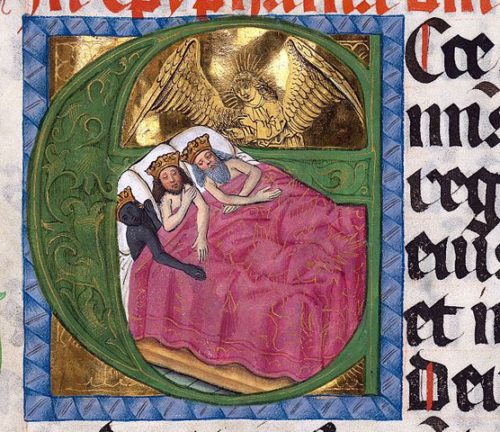
Reimagining the three kings as queer or female gives fresh meaning to Epiphany, a holiday celebrating the visit of the Magi to the baby Jesus. It is observed on Jan. 6. Travelling from afar, the Magi symbolize that Christ was born for everyone from all parts of the world.
The word “epiphany” also refers to a sudden, intuitive perception. By looking at the Bible and church history from a LGBTQ viewpoint, people can experience new insights — their own personal “epiphanies” of understanding. New interpretations of the wise ones known as the Magi include:
- Queer Magi. LGBTQ church leaders suggest that the Magi may have been eunuchs — people who today would be called gay, queer or transgender. Intriguing questions are raised by the artistic tradition of showing the of three Magi together in bed.
- Female Magi appear in various books, videos and artwork, including a controversial Epiphany painting by Janet McKenzie. Three Wise Ones embody different races — and some perceive a transwoman among them. Epiphany is also known as Women’s Christmas.
- Queer gifts are presented to the Christ child in an icon by William Hart McNichols.
Matthew is the only one of the four gospels to mention the Magi. It says they followed a star and brought three gifts — gold, frankincense and myrrh — but it does not specify how many of them visited the baby Jesus or when they arrived. Later generations are left to seek answers through study and faithful speculation.
Queer Magi for Epiphany: Fabulous clothing
Although they are often called the “three kings,” the Magi stand in contrast to worldly King Herod who sought world domination by massacring the “holy innocents” who might grow up to take his throne. The wise Magi who followed the star to find the newborn Jesus were more likely wizards who provided a higher wisdom or astrologists with expertise in cosmic balance. The English word “magic” comes form these magical Magi.
The Magi played the shamanic role often filled by eunuchs, an ancient term for LGBTQ people, says Nancy Wilson in her book Outing the Bible: Queer Folks, God, Jesus, and the Christian Scriptures.” She writes:
“They were Zoroastrian priests, astrologers, magicians, ancient shamans from the courts of ancient Persia. They were the equivalent of Merlin of Britain. They were sorcerers, high-ranking officials, but not kings—definitely not kings. But quite possibly, they were queens. We’ve always pictured them with elaborate, exotic, unusual clothing—quite festive, highly decorated and accessorized! …Also, the wise eunuchs, shamans, holy men were the only ones who had the forethought to go shopping before they visited the baby Jesus!
As Wilson pointed out, the Magi are often depicted wearing gorgeous, elaborate attire. Eunuchs and cross-dressers were surprisingly common in the Mediterranean world of the Bible and later.
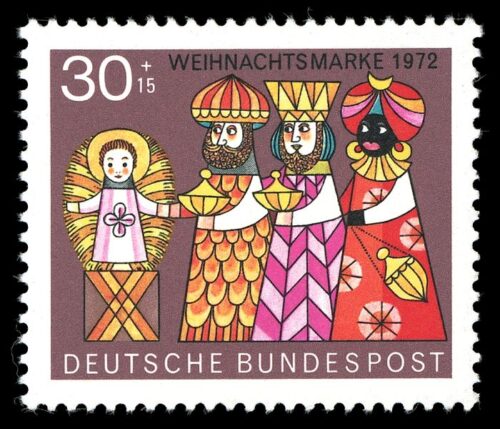
Three stylish Magi wear fabulous outfits on a 1972 German Christmas stamp (Wikimedia Commons)
Over time the story was embellished. Each Magi was given a name and a backstory in western tradition: White-bearded Melchior, the oldest, came from Persia and brought gold. Caspar came from India and brought frankincense. Beardless Balthazar, the youngest, had dark skin and came from Arabia or Ethiopia with the gift of myrrh. The Adoration of the Magi became one of the most popular themes in art. As the iconography evolved, Balthazar in particular tended to look especially queer or even campy.
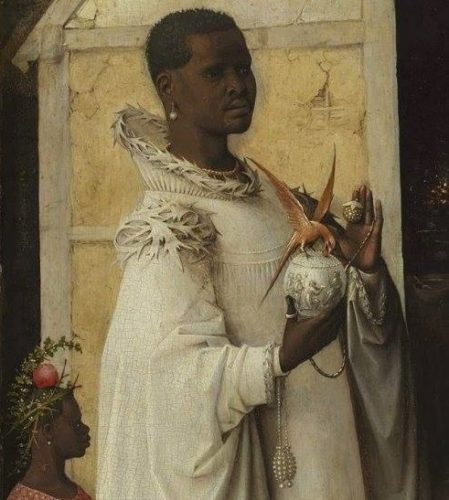
Balthazar from Adoration of the Magi by Hieronymus Bosch, c. 1510 (Wikipedia)
The concept of the queer Magi is amplified by Virginia Ramey Mollenkott, author of Omnigender. “My guess is that they were people who today would be termed transwomen,” she writes in the brochure “Gender Identity and Our Faith Communities.”
The idea of queer Magi is taken farther — some might say too far — in the fun music video “We Three Queens” by American drag queens Manila Luzon, Peppermint and Alaska.
By happy coincidence, a cross-dressing saint happens to have a feast day on Jan. 5, the day before Epiphany. Apollinaria / Dorotheos of Egypt, was assigned female at birth, but put on men’s clothing and entered monastic life as a eunuch named Dorotheos.
Queer Magi for Epiphany: Bed sharing and shamanic dreams
They also have shamanistic dreams. They deceive evil King Herod and actually play the precise role that many other prominent eunuchs play in the Bible: they rescue the prophet, this time the Messiah of God, and foil the evil royal plot against God’s anointed.”
One of the Magi’s shamanic dreams is recorded in the Bible. The gospel of Matthew says that after the Magi found the baby Jesus, God came to them in a dream and warned them not to return to King Herod. They went back home another way, thus thwarting Herod’s plan to locate and kill the infant Messiah.
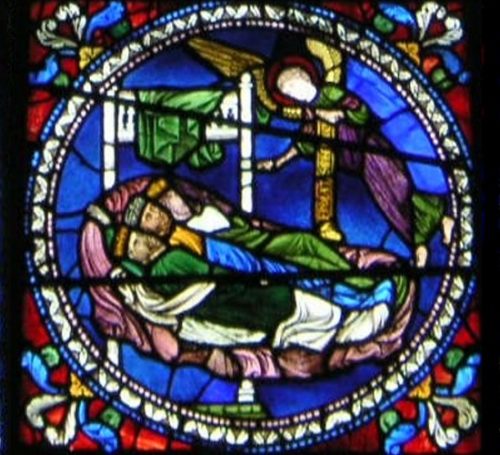
“The Dream of the Magi” stained glass window, Canterbury Cathedral, England, 13th century (Wikipedia)
The dream of the Magi was a common motif in medieval European art. These little-known images startle today’s viewers by showing the three kings together as an interracial male trio in one bed — sometimes shirtless and maybe even nude under the covers (but always wearing their crowns).
This looks like a homosexual liaison to many people now, but bed-sharing was a common custom in the Middle Ages. Back then people usually engaged in communal sleeping, not sexual activity, when sharing a bed with traveling companions, family members, colleagues and others. Still these historic artworks do provide a visual aid for considering the queer side of the Magi.
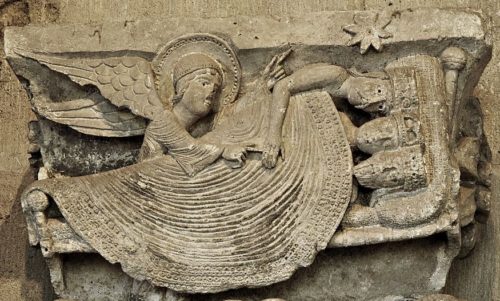
“The Dream of the Three Wise Men” sculpture by Master Gislebertus, Cathedral of Saint-Lazare, Autun, France, 1120-30. An angel wakes one of the magi as they sleep together under a star. (Wikipedia)
Female Magi for Epiphany
Female Magi have been envisioned by artists in a gender-bending move that sometimes causes controversy. Epiphany itself is celebrated as “Women’s Christmas” (Nollaig na mBan) in Ireland, where men assume the household duties for the day so women can celebrate together at the end of the holiday season.
A multi-racial trio of female Magi visits the baby Jesus and his mother in “Epiphany” by Vermont artist Janet McKenzie. Instead of the traditional three kings or three wise men, the artist re-interprets the Magi as wise women from around the world.
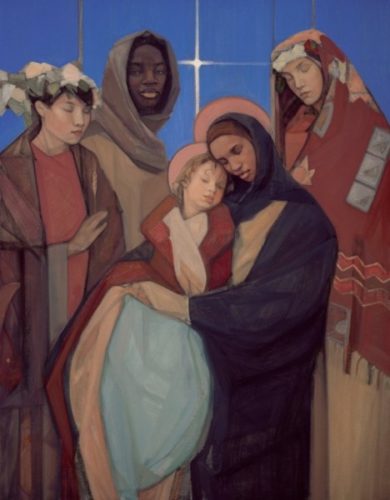
“Epiphany” by Janet McKenzie
“More than a few people have asked about the gender of the tallest Magi in Janet’s ‘Epiphany’ image. Male? Female? Trans? I find that stunningly wonderful because possibly three minority groups might be embodied in this portrait in the eyes and imaginations of so many viewers!” said Barbara Marian, who commissioned the McKenzie painting.
The unconventional portrayal of the Magi makes good theological sense. Marian explains: “The story of the Magi in the Gospel of Matthew allowed the Jewish followers of Jesus to imagine the unthinkable — God’s grace extending to the outsiders, the gentiles. Who are the outsiders in our world? Can we imagine the favor of God extending beyond the human boundaries of race, class, nationality, ethnicity, religious devotion, and gender?”
Marian commissioned “Epiphany” for the Nativity Project, which revisited and revitalized the Gospel with new images of women. “It’s easy to get so caught up in regal images of Matthew’s night visitors that we miss the core message — Christ for all people,” Marian says. In 2015 she donated them to the Catholic Theological Union in Chicago.
 A 2017 illustrated book on the theme is “Three Wise Queens: A Story of the Nativity” by James Allen, with illustrations by András Barlogh. The multiracial trio named Hekima, Sophia and Mingzhi journey across three continents to find a baby unlike any other in Bethlehem.
A 2017 illustrated book on the theme is “Three Wise Queens: A Story of the Nativity” by James Allen, with illustrations by András Barlogh. The multiracial trio named Hekima, Sophia and Mingzhi journey across three continents to find a baby unlike any other in Bethlehem.
Jan Richardson, an artist and Methodist minister in Florida, also portrays the Magi as women of different races in “Wise Women Also Came,” an image that appears on the cover of her book “Sacred Journeys: A Woman’s Book of Daily Prayer.”
Controversy over female Magi by Janet McKenzie
Conservative Christians protested against the inclusive “Epiphany” in 2007 when it appeared on the Christmas cards of the Most Reverend Katharine Jefferts Schori, presiding bishop of the Episcopal Church.
The Standing Committee of the Episcopal Diocese of Ft. Worth, Texas, sent a notice to clergy and 2007 convention delegates condemning Jefferts Schori for her choice of art. “Happy Multicultural Feminist Celebration Day,” sneered the headline of a traditional Anglican blog where nearly 100 comments were posted condemning the image as “stupid,” “faux-nouveau hipster theology” and worse. For more info, see my previous post Conservatives blast inclusive Christmas card.
McKenzie denies the accusations that she is trying to be divisive and rewrite scripture. “Of course this is as far from my thinking as possible,” she says. “I feel called to create sacred and secular art that includes and celebrates those systematically ignored, relegated and minimized, and for the most part that is women and people of color.”
The artist continues to be amazed that her loving images provoke so much anger. “Even this gentle image of a loving Holy Mother and Child, with no agenda except to include and honor us as the nurturing feminine beings we are, surrounded in community with other women, is still misunderstood — even at this late date,” she says.
McKenzie has weathered even bigger storms before. Her androgynous African American “Jesus of the People” painting caused international controversy when Sister Wendy of PBS chose it to represent Christ in the new millennium.
Critics focus on the content of McKenzie’s art, but her outstanding artistic style is one reason that her work attracts attention. The Vermont artist uses drawing and line with oils to build images that glow. Her painting technique and pastel colors are reminiscent of American Impressionist Mary Cassatt, who is famous for painting intimate scenes of mothers and their children.
The controversy over McKenzie’s work is a reminder of the power of art, and the continuing need for progressive spiritual images. Opposition seems to fuel her passion to paint. “We all need to find ourselves included within the sacred journey of life, and afterlife,” McKenzie says. “I have been surprised to find archaic and out-dated hate still in place, still alive and well and fueled by fear, in response to some of my art. I have made the decision to respond to such hate not in the way it comes to me, but by creating ever more inclusive art that confronts prejudice and hate. The only path open to any of us is the one of love.”
McKenzie’s art is featured in the book “Art That Dares: Gay Jesus, Woman Christ, and More” by Q Spirit founder Kittredge Cherry and in McKenzie’s book “Holiness and the Feminine Spirit.”
Queer gifts for Epiphany
William Hart McNichols paints another kind of queer Epiphany. McNichols is a New Mexico artist and Roman Catholic priest whose gay-positive icons have caused controversy. He worked at an AIDS hospice in New York City from 1983-90, when many in the gay community were dying of the disease. During that period he painted “The Epiphany: Wisemen Bring Gifts to the Child.”
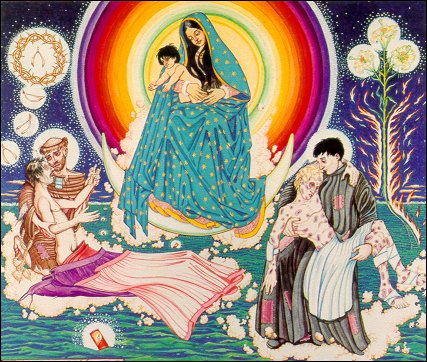
“The Epiphany: Wisemen Bring Gifts to the Child” by William Hart McNichols © 1984
Francis of Assisi and Aloysius Gonzaga are the wise men visiting the baby Jesus in this icon. Instead of the usual gold, frankincense and myrrh, the “gifts” they bring to the Christ child are people with AIDS, perhaps gay men. The baby Jesus reaches eagerly to receive these gifts. The child and his mother appear in a form popular in Mexico and other Latinx cultures as Our Lady of Guadalupe and El Santo Niño de Atocha. The halo around them echoes the colors of the rainbow flag of the LGBTQ community. McNichols offers a prayer with this icon:
Dearest Mary, Our Lady of Guadalupe,
Mother of the poor and the oppressed,
we watch full of reverence
and joy as St. Francis and
St. Aloysius bring the gifts of
these two people afflicted with AIDS
to the Holy Child in your arms,
who is so eager to receive them.
Teach us to find and embrace
your Son Jesus in all peoples,
but most especially those who
are in greatest need and
who suffer most.
Amen
In closing, the question arises: What gifts are queer people bringing today to Christ, the church and the world?
Progressive Epiphany links
LGBTQ Nativity 4: Queer Magi visit Mary, Josephine and Jesus
“Wise Women Also Came” and Women’s Christmas by Jan Richardson
Three Wise Men in a Bed: Bedsharing and Sexuality in Medieval Europe (notchesblog.com)
___
Top image credit:
“The Dream of the Magi,” Salzburg Missal, Regensburg, Germany, 1478-1489 (Wikipedia)
___
This post is part of the LGBTQ Calendar series by Kittredge Cherry. The series celebrates religious and spiritual holidays, events in LGBTQ history, holy days, feast days, festivals, anniversaries, liturgical seasons and other occasions of special interest to lesbian, gay, bisexual, transgender and queer people of faith and our allies.
This article was originally published on Q Spirit in January 2017, was expanded with new material over time, and was most recently updated on Jan. 6, 2024.
Copyright © Kittredge Cherry. All rights reserved.
Qspirit.net presents the Jesus in Love Blog on LGBTQ spirituality.







Fabulous article Kitt! The story of the killing of the innocents is so pertinent at this time in Palestine.
I actually wrote an article called “Holy Innocents Day: Queer genocide?” It needs to be updated so I haven’t moved it over to Q Spirit yet. But this (slightly edited) paragraph still sums up the main idea well:
“The slaughter of the innocents also has a LGBTQ connection. Last year’s post about Holy Innocents Day led to a flurry of comments about female infanticide and selective abortion of unborn lesbians, gays and transgender people. The threat of this kind of “massacre of the innocents” is real and it provokes real fear and rage.”
At least this article admits that sharing a bed was the norm in medieval society, but it repeats the inexcusable claim that the word “eunuch” was “an ancient term for LGBTQ people”. A eunuch was a castrated man, which doesn’t make someone LGBTQ unless you really stretch the definition of the latter. And the fact that the Magi are portrayed in fancy clothing is simply a function of their status in society (assumed to have been either kings or astronomer-priests who would have had a great deal of wealth). Even if they had been the latter, they would not have been “shamans” as this article claims: they would have tracked the positions of the stars and planets, more akin to a modern astronomer than a “shaman”.
This is nothing new. This is ancient as apple pie and history all over the planet. thank you. Happy New Year.
Thank you for this thoughtful, insightful, and inspirational piece. There are many ‘roads’ to Bethlehem, a journey that invites us all. May we accept this invitation and welcome ALL travelers who seek to know and experience the amazing, scandalous, and unconditional love of God. Surely, we will all be transformed in the process, going ‘home’changed forever.
Amen! Thank you for your beautiful Epiphany prayer.
This may or may not be significant, but I can tell you this peculiar fact regarding the Magi and your speculation here. In the birth chart of Jesus I claim to possess expanding upon the D’Occhieppo/Hughes thesis about Christ’s birth that even Pope Benedict described as plausible, the asteroid Chaldaea is in exact favourable aspect to Saris (eunuch) – 14 Aquarius to 14 Libra.
I am sure that Chaldaea represents the Magi in particular and could be called their sensitive degree,it works as such – in turn it even exactly aspects asteroid DavidHughes, name of the noted astronomer who has pushed the relevant thesis in the English speaking world. I don’t recall the exact details, but I do remember that Chaldaea was afflicted when there was first talk that the Magi were women. Women they weren’t but they could indeed have been eunuchs, meaning precisely whatever by that word since it had become a bit broad and ambiguous by Jesus’ time.
My “Testament of the Magi” (new edition book and kindle at Amazon goo.gl/I28aCm )is not primarily a work of gay theology as such, but especially its second half is able to answer just about any and every question about Jesus in love and relation and sex like did he marry the Magdalene, was John the Beloved Disciple and so on that anyone might ever have. Numerous problems historical, psychological, theological around Jesus are covered in this ground breaking all encompassing tour de force but which few wish even to look at. Nowadays astronomers and scientists alone must be allowed the last word in this area, not doctors of religious studies and astrologers. There is a snobbish, academic exclusiveness in this area. The fuss around the nonsense about no Bethlehem Star from Notre Dame university astronomer Grant Matthews this last Christmas when I tried in vain to get some messages across, is a case in point. The controversy even showed up in Jesus’ still consistently working chart. See recent article at http://wp.me/p2v96G-Qn
For the general good in opening up more conversations, it is disappointing and regrettable that my work is not more known but that tends to be the fate of us who are not Americans and in discussing Christ’s birth not astronomers either!